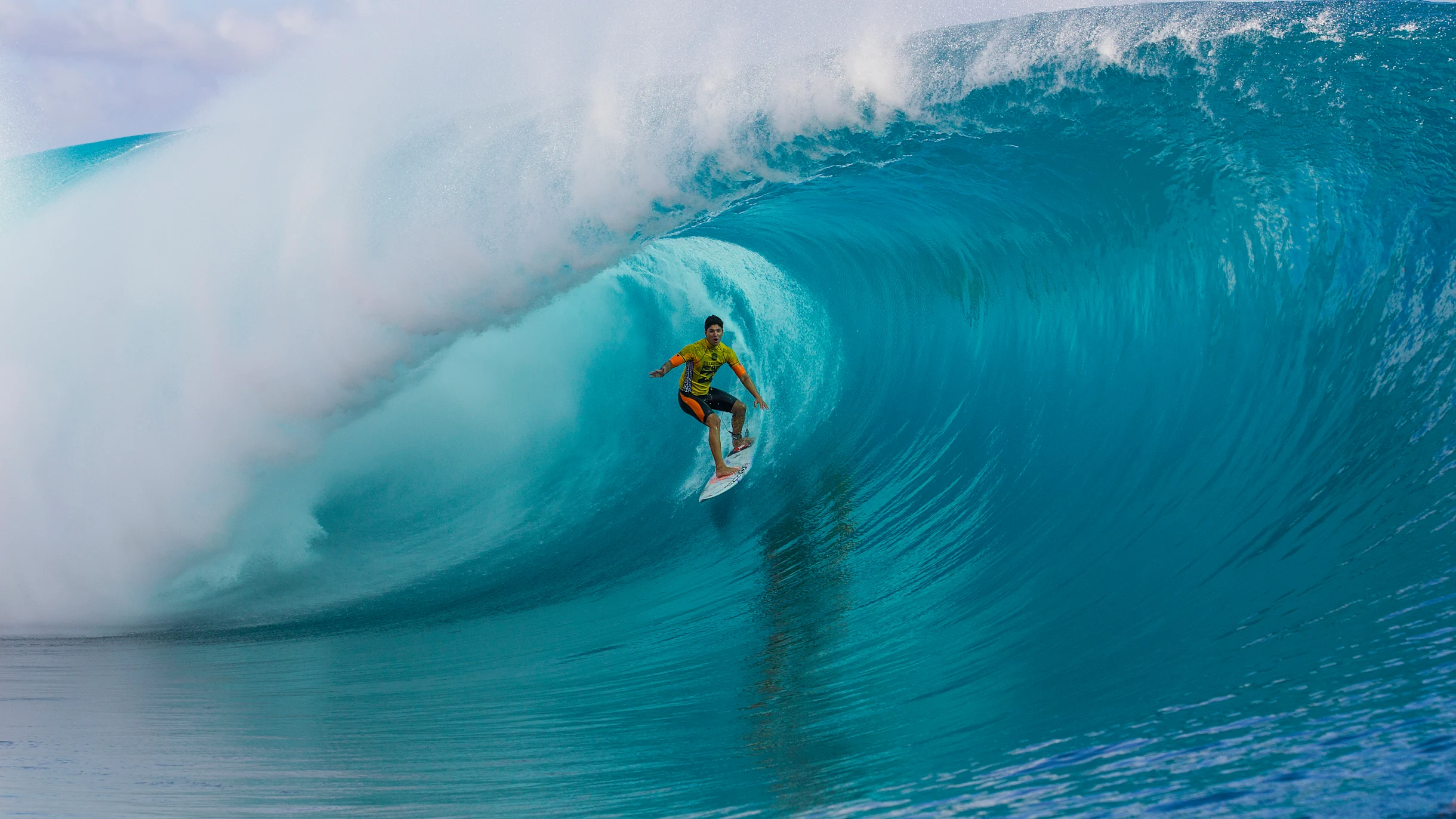For Henry Tahurai, the ocean has always been part of the rhythm of life. The 31-year-old father grew up fishing, diving and surfing where he lives in Teahupo’o, next to the famed surf break in Tahiti.
“There’s waterfalls and a river coming down from the mountains and going through [our] village, and we got a nice bay, facing the most beautiful wave in the world,” Tahurai says.
Known for its big barrels and proximity to the reef, Teahupo’o is among the most breathtaking and dangerous waves in the world. Part of French Polynesia, it will host the 2024 Olympic surfing event as organisers say they want to spread the Games across France. Yet the decision has prompted concern from the town’s 1,500 residents over the risk of environmental damage to the ocean and surrounding areas, parts of which are protected.
Some are worried about how the island in the South Pacific will cope with the influx of people and infrastructure required for the event. The judges’ viewing tower – to be built in the water – may need to hold up to seven times the number of people as in other pro-surfing events held in Teahupo’o. Plans to accommodate the competitors on cruise ships stationed off the coast have also prompted concerns over pollution and harm to the reef.
Like many other residents, Tahurai feels excited about having an Olympic event in his town but says he was initially “scared” over what may happen to the “little piece of paradise”.
“I’d go to war to keep this place the way it is … We gotta keep Teahupo’o Teahupo’o,” Tahurai says. “We’re not doing it for us, we’re doing it for the next generation.”
The village of Teahupo’o is a modest collection of family homes, with a few guesthouses and one or two small snacks – local-style eateries. Many live past the end of the island’s main road and can access their homes only on foot or by boat.
Teahupo’o mayor, Roniu Poaru, says that as Olympic preparations continue, the “wishes of our population are paramount”.
“Our population accepts the Olympic Games, but that comes with conditions … the goal is to preserve our environment.”
Initially, there were proposals for big projects such as an Olympic village in Teahupo’o, as well as a bridge over the river, which would allow vehicles access to the site. A hotel renovation project was also on the cards. Many residents, however, were staunchly opposed to the plans.
“I wasn’t against the Olympics being held here in Teahupo’o, but I was against all the buildings they wanted to build,” says Cindy Otcenasek, president of the environmental defence association Vai Ara o Teahupo’o.
For the past year, residents and environmental groups worked together to oppose the constructions. They went to local media to raise awareness, which was met with support.
After months of meetings between residents, government and the Olympic organising committee in Tahiti, it was agreed that any new infrastructure in Teahupo’o would be kept to a minimum. The Olympic committee says it is working with residents to develop the site for the event, to be held in July next year.
“We have really tried to adapt to the site and to the environment in the interests of the population of Teahupo’o, even though this has caused a lot of logistical difficulties … but we really want to be respectful,” says Barbara Martins-Nio, general manager of the 2024 Paris Olympic committee, based in Tahiti and in charge of the surfing event.
Martins-Nio tells the Guardian that the committee will build permanent infrastructure in line with local and government requests. “We will build a pedestrian‐only bridge in Teahupo’o, which is necessary to cross the river to the peninsula … we will also accelerate the deployment of fibre internet services, as well as the deployment of clean drinking water ,” she says.
Still, much of the required development brings challenges.
Discussions are under way concerning the construction of the judges’ tower on the reef. As the wave in Teahupo’o is about 400 metres from the shoreline, officials and judges need a viewing platform in the lagoon to see the competitors clearly.
Teahupo’o hosts other international surfing events, including the World Surf League’s Tahiti Pro. During WSL events, the judges’ platform accommodates 10 to 20 people. For the Olympics, the platform may need to accommodate up to 150 people, which could impact the lagoons’ coral reef.
Dr Sam Purkis, chair of Marine Geosciences at the University of Miami, says an infrastructure development could pose risks to ocean life.
“Coral reefs are delicate ecosystems and any construction atop them, or in their vicinity, has the potential to damage the reef,” he says. Adding any platform must be built “in the most unobtrusive way feasible, and ensure these activities occur when the coral reef is not stressed by other factors, such as excess temperature”.
Temporary structures are also planned for the site, which will be used mainly for overseeing operations and will be taken down once the Games are finished. One area of 20,000 sq metres has been set aside in Teahupo’o for the centre of operations. Martins-Nio says the local population has asked that the land be used as a taro plantation after the Games.
Finding suitable accommodation in Teahupo’o, an area of Tahiti where there are no hotels, presents another logistical and environmental challenge. Olympic staff members, press and officials will be housed in local guesthouses and with residents; 350 rooms have already been reserved for the staff.
Unlike other Olympic events, spectators will be few in Teahupo’o. It is estimated there will be 600 places for spectators on the beach. The Olympic committee will also be setting up viewing screens for spectators in the west coast town of Papara and in the capital city, Papeete, for around 18,000 people.
The 48 athletes and their teams, however, will be staying on two cruise ships to enable them to be close to the wave. It is the first time athletes will be housed on a cruise ship during competition in Teahupo’o. The decision has raised environmental concerns over the release of harmful gas emissions that may contribute to air and ocean pollution.
Otcenasek says the cruise ship “is not the best solution – the motors run all day – but it’s the one that won’t leave any lasting trace in Teahupo’o”.
Martins-Nio says the Olympic committee is working to offset or reduce the environmental impact the cruise ships will have on the environment. A compensation plan is being developed, she says, without providing more details.
Marine scientist Dr Purkis says: “Providing that the ships anchor on sand and do not discharge their waste into the bay, the impacts of their presence will hopefully be minimal. In the end, it is the reef edifice which has grown over millennia which creates the wave that the competitors seek.”
As the Games draw closer, the people of Teahupo’o remain excited about the event but protective of their homeland.
“The Olympics are welcome here,” Tahurai says, “but leave this place as beautiful as it was when you saw it for the first time.”
SOURCE: THE GUARDIAN/PACNEWS


















